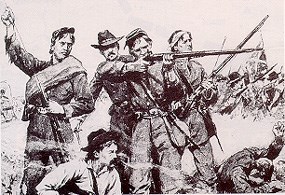
Library of Congress Image THE DEATH KNELL OF THE CONFEDERACY You are invited to explore the Appomattox Campaign through the VA Historical Highway Markers guide. On the evening of April the 8th, General Robert E. Lee and the remnants of his once-proud Army of Northern Virginia arrived in Appomattox County one step ahead of the pursuing Federal Armies. Lee's hope was to reach Appomattox Station on the South Side Railroad where supply trains awaited. Having moved ahead of the rest of Lee's army, General Rueben Lindsay Walker led a detachment of reserve artillery to bivouac near the station, a mile west of the village of Appomattox Court House. It was not long after their arrival - around 4:00 pm - that Federal cavalry, riding hard from the southeast, captured the waiting, and unprotected, supply trains and moved west to begin an assault on Walker's reserve artillery camp. This cavalry, under the overall command of General Philip Sheridan, was merely a harbinger of the fast approaching Federal infantry columns. By 8 - 9 o'clock that evening, and after multiple charges, Sheridan's horsemen dispersed Walker's artillerists and Lee's much coveted rations and supplies were now in Federal hands. In the meantime, the majority of Lee's forces were setting up a temporary camp one mile northeast of Appomattox Court House, the small town lying between the Confederates and the station. Word of the victorious Federal advance soon reached the Confederate camp. The beleaguered Confederates realized that Grant's men had the upper hand. A Confederate trooper reflected: "I felt myself now to be near physical collapse... expecting to go into battle in the morning." The expectation was validated when, at 2:00 A.M. on the morning of April 9th, Lee ordered General Gordon's II Corps to move into line of battle west of Appomattox Court House. Lee had met with Generals Gordon, Longstreet, and his nephew, Fitzhugh Lee earlier that evening and decided to throw a portion of his infantry against Sheridan's men. Lee certainly did not expect to have to fight Federal infantry, believing that he had outmarched most of Grant's troops moving west from Farmville. After much delay, General Brian Grimes, of North Carolina, ordered the attack. At 9:00 that morning, he sent Gordon's II Corps forward to break through the Federal cavalry and proceed west in an attempt to open the crucial Richmond - Lynchburg Stage Road, Lee's intended route of retreat. Protecting Gordon's right flank was Fitzhugh Lee's cavalry. Gordon's Corps, "fought to a frazzle" during the previous week, was a mere shadow of it's former strength. The combined force of the Confederate infantry and the cavalry sent into the fight numbered less than 9, 000 men. Lee's nephew "Fitz" and his cavalry spearheaded the advance, and the lines of grey-clad infantrymen lurched forward; most men somnolent from their early rising yet nervous with the anticipation that manifests itself before an impending battle. As the line moved up the sloping ridge along the Richmond-Lynchburg Stage Road, the advanced Union cavalry came into view behind their hastily erected breastworks. Situated on the crest of the hill and beyond were two Federal artillery pieces and a brigade of cavalry under General Charles H. Smith. Smith had been ordered by his division commander, General George Crook, to hold his position as long as possible. The Confederates met with initial success, advancing over the crest of the hill, capturing Smith's artillery, a number of blue breasted Federals and leaving the rest of Smith's men to flee in their wake. The initial success of the Confederates was stalled by the arrival on the field of Mackenzie's and Young's Federal cavalry brigades. From his advanced position "Fitz" Lee began to see large numbers of Federal infantry moving forward to join the fray. John Gordon sent a message to Lee that Federal infantry was arriving on his front in force, and that he would not be capable of dealing with them without additional re-enforcements. It now became apparent to Gordon that Lee had grossly underestimated the number of Federal troops in front of the army. In truth, Grant had not only positioned more cavalry in front of Lee during the night, but had also force-marched portions of three corps of infantry along the South Side Railroad to arrive at Appomattox Station during the night of the 8th and early morning of the 9th. Most of the Army of the James (under Gen. Edward Ord) -- the XXIV and elements of the XXV (United States Colored Troops)-- had moved to block Lee's western escape route with the Army of the Potomac's V Corps in tow. Gordon and his battle-worn foot soldiers now faced advancing lines of dark blue-clad Federal infantry -- men of the XXIV and XXV Corps. As Gordon's men began to skirmish with the Federal Infantry, two Federal cavalry divisions converged on the Confederate lines alongside infantry of Griffin's Federal V Corps. It was only a matter of time before Gordon's men broke. In an attempt to save his command most of "Fitz" Lee's cavalry skirted the Federals and escaped westward toward Lynchburg. The Confederate infantry withdrew from their advanced positions. On learning the situation on Gordon's front, Lee realized that his options were now played out. General Lee ordered truce flags sent out at about 11:00 that morning, and sent a note to General Grant asking for a meeting to discuss the surrender of the Army of Northern Virginia. Casualties of these two battles have been estimated at nearly 500 total dead and wounded.
|
Last updated: March 31, 2012
